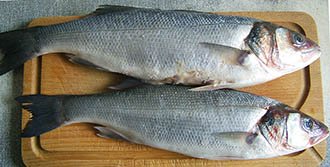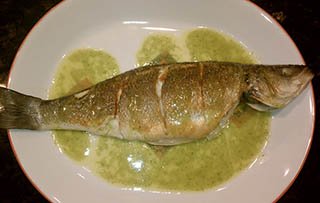Branzino Nutrition facts
European bass or Branzino is a round, non-oily, tropical ocean fish predominantly found in the North Atlantic and Mediterranean Sea. In French, European sea bass is also referred to as loup de mer, while in other regions it may be known as white salmon, Spigola, Lubina, or simply as bass.
Scientific name: Dicentrarchus labrax, belonging to the Moronidae family, which also includes yellow bass and white perch.
 |
| Branzino (European sea bass). Photo credit-LHOON |
Branzino, known as the Italian name for this silver-skinned fish, is highly prized in Mediterranean cuisine for its lean, firm, white, and delicate flesh.
The spotted seabass (Dicentrarchus punctatus) is a close relative found in temperate marine and brackish waters of the eastern Atlantic and the Mediterranean Sea.
Chilean sea bass (Patagonian toothfish) is a distinct species native to coastal waters of Southern Chile and Argentina.
Striped American sea bass (Morone saxatilis) is also a separate species found in the Eastern coastal waters of the United States.
Habitat
European sea bass inhabit coastal waters in small schools, although they are sometimes found in brackish or freshwater environments. They can also be spotted in saltwater lakes, lagoons, and certain large river estuaries. Branzino primarily feeds on small fish, crustaceans, and fish eggs.
Description
Branzino, also known as the European seabass, is a round, warm-water marine fish. It is easily recognizable by its silvery-grey, scaly, elongated body, featuring two separate dorsal fins and rayed anal fins. The anal fin is slightly forked.
Ranging in size from one and a half to three pounds, it boasts a firm, white, delicate-flavored flesh with few small bones. In Italy, sea bass are intensively bred in salty waters.
Adult fish typically measure between 30 to 50 cm in length and weigh between one and a half to three pounds. Commercial farming of sea bass is successfully undertaken on Italian Mediterranean coasts for export to the United States.
Health Benefits of Branzino
European sea bass (Branzino) is a low-calorie round fish, containing just 97 calories per 100 grams.
It is a non-fatty (white fish) oceanic fish; nonetheless Branzino is a noteworthy source of omega-3 fatty acids, although in lower quantities compared to oily fish.
Branzino is one of the finest source of essential fatty acids, protein, minerals, and fat-soluble vitamins such as vitamins A, E, and D (cholecalciferol).
Wild, line-caught sea bass provides a significant amount of vitamin D, with 100 grams containing 226 IU (56.5% of the daily recommended intake). Vitamin D plays crucial roles in immunity, cancer prevention, and bone health.
Branzino's lean, white meat offers a favorable amino acid profile, providing 18.43 grams of protein per 100 grams (33% of the recommended daily intake), with all essential amino acids present in healthy proportions.
Its lean meat is a good source of polyunsaturated fatty acids (PUFA); with studies suggesting that regular consumption may reduce the risk of heart-related conditions like heart attacks, strokes, obesity, and hypertension.
Classified as a "best choice" by the US-FDA due to low methyl-mercury levels, Branzino is recommended for consumption 2-3 times a week.
Branzino serves as a moderate source of omega-3 fatty acids, including eicosapentaenoic acid (EPA), docosapentaenoic acid (DPA), and docosahexaenoic acid (DHA), which are crucial for nervous system development, particularly in infants and children.
According to Cornell University and the New York Sea Grant Extension Program. 2012, The fatty acids play a crucial role in decreasing blood pressure and heart rate and help improve cardiovascular function. For example, research has shown that omega-3 fatty acids decrease the risk of arrhythmias (abnormal heartbeats) that can lead to sudden death.
In adults, several large trials have assessed the impact of fish or fish oils on heart disease. In the "GISSI Prevention Trial", individuals who had suffered heart attacks and took a 1-gram capsule of omega-3 fats daily for three years were less likely to experience a recurring heart attack, stroke, or sudden death compared to those who received a placebo.
European sea bass, being a deep water, non-oily fish, contains moderate amounts of vitamin A (154 IU/100g). Moreover, its omega-3 essential fatty acids contribute to maintaining healthy mucosa and skin.
A 100 g serving of European sea bass fillet provides 0.400 mg of pyridoxine (B-6) (31% RDA) and 1.6 mg of niacin (10% RDA). It also serves as a good source of vitamin E, vitamin B12, thiamin, and riboflavin.
Branzino fillet stands as a naturally rich source of minerals, including selenium (36.5 µg or 66% RDA), iodine, calcium, zinc, potassium, phosphorus, and magnesium. Iodine, in particular, is an essential trace element crucial for thyroid hormone synthesis.
| Principle | Nutrient Value | Percent of RDA |
|---|---|---|
| Energy | 97 Kcal | 5% |
| Carbohydrates | 0 g | 0% |
| Protein | 18.4 g | 33% |
| Total Fat | 2 g | 10% |
| Cholesterol | 41 mg | 14% |
| Dietary Fiber | 0 g | 0% |
| Vitamins | ||
| Folate total | 5 μg | 1.25% |
| Niacin | 1.6 mg | 10% |
| Pyridoxine | 0.4 mg | 31% |
| Riboflavin | 0.12 mg | 9% |
| Thiamin | 0.05 mg | 4% |
| Vitamin-A | 154 IU | 5% |
| Vitamin-C | 0 mg | 0% |
| Vitamin-D | 226 IU | 56.5% |
| Vitamin-E | 0.84 mg | 5.60% | Electrolytes |
| Sodium | 58 mg | 4% |
| Potassium | 256 mg | 5.5% |
| Minerals | ||
| Calcium | 10 mg | 1% |
| Iron | 0.29 mg | 3.5% |
| Magnesium | 41 mg | 10% |
| Phosphorus | 194 mg | 28% |
| Selenium | 36.5 mg | 66% |
| Zinc | 0.4 mg | 3.6% | Omega-3 fats |
| EPA (20:5 n-3) | 0.161 g | -- |
| DPA (22:5 n-3) | 0.076 g | -- |
| DHA (22:6 n-3) | 0.434 g | -- |
Buying
Branzino is readily available year-round in US markets, either as whole fish or fillets. The peak season for freshness is in spring or early summer, prior to spawning. Look for vibrant, firm fish exhibiting silvery skin, pink gills, and clear eyes.
Fresh, wild-caught branzino commands higher prices compared to farm-raised varieties. However, farmed bass offers a more budget-friendly option and is consistently available throughout the year. Farmed bass tend to be larger and may have a slightly higher fat content.
When storing at home, keep fish and fillets refrigerated for 2-3 days. For longer preservation, scale and gut whole fish before freezing.
Preparation and serving methods
If you buy whole fish, cleaning branzino involves removing the fins, scaling the body, and making a belly incision to remove the innards. After thorough washing inside and out, pat dry with a cloth before cooking or refrigerating.
Branzino is one of the finest fish renowned for its minimal bones, firm flesh, and delicate flavor, making it ideal for stuffing, grilling, or baking while retaining its shape.
Here are some serving ideas:
 |
| Branzino. Photo credit: kyopia |
Branzino is a versatile fish. Depending on the serving size, smaller fish can be used for stuffing with lemon slices and herbs, while larger fish can be filleted and are great for grilling or pan-frying.
Prepare a gratin with sea bass, bacon, potatoes, capers, and cream sauce.
Safety profile
Wild-caught Branzino is categorized with ratings 3 and 4 (yellow and amber). Given the existence of better-rated sustainable alternatives, efforts should be made to limit Branzino fishing as much as possible.
The methyl mercury levels in European sea bass are measured at 0.167 Parts Per Million (PPM). As per the U.S. FDA's final guidelines regarding the consumption of fish for expectant and breastfeeding mothers, which include lists of safe options and those to avoid, sea bass falls under the "best choice" category. According to these guidelines, individuals can consume 2-3 servings of sea bass per week. (Medical disclaimer)
Also read ≻≻-
≻≻- Mercury in Fish: Health Benefits, Risks, and Safe Choices
≻≻- Atlantic Cod nutrition facts and health benefits.
≻≻- Salmon nutrition facts and health benefits.
≻≻- Halibut nutrition facts and health benefits.
≻≻- Trout fish nutrition facts and health benefits.
≻≻- Back to Seafood from Branzino fish nutrition facts and health benefits.
≻≻-Back to Home page.
Further reading (Links opens in new window):
Seafood guide -PDF.
Omega-3 Fatty Acids: An Essential Contribution.